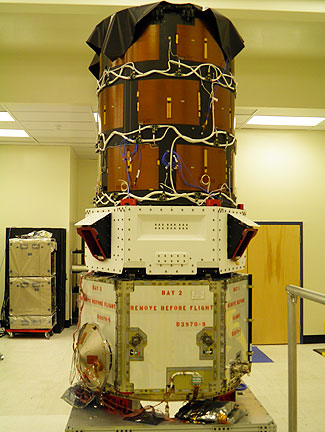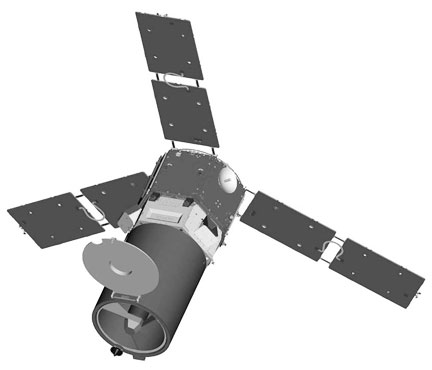
The ORS-1 satellite photographed during environmental testing last year at the Goodrich Corp.'s Danbury, Ct., facility. Photograph is courtesy of Goodrich Corporation
Scheduled to launch late spring 2011, from NASA’s Wallops Flight Facility, Wallops Island, Va., the ORS-1 satellite, led by the Operationally Responsive Space office here, features a modified version of the SYERS-2 sensor, currently flown on the U-2 aircraft, which will provide rapid, crucial data to U.S. Central Command.
Working directly with USCENTCOM to make certain the capability being provided meets requirements and expectations, a significant portion of the past two years during the design, development, testing and pre-launch phases has been to keep them involved in each process,” said Thom Davis, ORS-1 mission manager, ORS office. “ORS-1 is a joint effort between the services including USCENTCOM, the U.S. Army, the U.S. Naval Research Laboratory, and Air Force Space Command. The key to date, in terms of our success, has been the ability of the team to work together.”
ATK Aerospace Systems Group, Beltsville, Md., constructed ORS-1’s frame using the same model as that for Tactical Satellite-3, which in June 2010, after a successful 13-month mission, transferred from an Air Force Research Laboratory experimental demonstration to an operational unit managed by Air Force Space Command. Currently, ORS-1 resides at the Goodrich ISR Division in the Company's Danbury, Ct., facility until transport next month to the NASA Wallops Island launch site for integration with the Minotaur I launch vehicle. In October 2010, the company integrated the modified SYERS-2 sensor with the spacecraft bus and two months later, started environmental testing of ORS-1. The space vehicle is currently undergoing thermal vacuum testing, which began on March 17. As the executing agent for the ORS Office, the Space and Missile Systems Center’s Space Development and Test Directorate, also at Kirtland AFB, has acted as the system program office and managed the design, development, integration and test activities of ORS-1’s road to liftoff. This includes the spacecraft, the satellite command and control system, the mission data processing and the launch vehicle.

Illustration of the ORS-1 satellite, an operational prototype, scheduled for a one- to two-year mission. The spacecraft features a modified version of the SYERS-2 sensor used on U-2 aircraft. Image is courtesy of the U.S. Air Force.
Information obtained by ORS-1’s SYERS-2 modified sensor will be transmitted to the ground via a common data link radio, similar to the kind of radio used to deliver ISR-modified data to the ground from airborne platforms like unmanned aerial vehicles. At that point, Army exploitation analysts will analyze the transmissions and then send the information back to USCENTCOM operators for use by the warfighter. “It is an incredible team that has worked very, very hard over the last two and a half years to make this mission possible and it’s really focused on providing capability to USCENTCOM,” said Dr. Wegner, ORS office director. “We focus very much everyday on those Sailors, Soldiers, Airmen, and Marines that are deployed around the world in harm’s way. If we can do our part to give them situational awareness about what is going on around them, we can help protect them and make sure they return home safely.”

